Carl E. Olson's Blog, page 80
September 8, 2014
New: "The Accidental Marriage: A Novel"
Now available from Ignatius Press:
The Accidental Marriage: A Novel
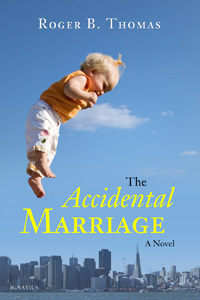
by Roger B. Thomas
The Accidental Marriage - Electronic Book Download
See more great novels at www.IPNovels.com.
What does heroism look like? When does friendship become too costly? Do we ever truly touch one another, or are we doomed to walk alone forever? Can love survive trials, or does it inevitably wither and die?
The Accidental Marriage is a contemporary story that explores these questions through vibrant, sympathetic characters whose struggles and triumphs illustrate that love doesn't always look like you would expect.
Scott and Megan are friends who live and work in the vibrant San Francisco Bay Area. Mostly contented with their jobs and same-sex relationships, they meet for lunch and sympathetic conversation from time to time.
When Megan's partner wants a baby, Scott offers to help. The ensuing complications force Scott and Megan to grapple with how much they're willing to sacrifice for friendship and for the child they've conceived. When Megan's situation unravels, Scott must step up to responsibilities he's never assumed before. Then his circumstances start to crumble, and a series of misfortunes strip them of everything but each other.
Roger Thomas, a lifelong Michigan resident, has been married to his wife Ellen since 1981. They have six grown children and eight grandchildren. He is a self-employed computer consultant. He loves reading, and his favorite authors include C.S. Lewis, J.R.R. Tolkien, Rudyard Kipling, and P.G. Wodehouse. He has had two collections of short stories published by Ignatius Press, and is working on his second novel.
Praise for The Accidental Marriage:
"In The Accidental Marriage, Roger Thomas plunges into the hot button issues of our day. He fearlessly explores questions about what terms like 'love' and 'marriage' really mean, all the while drawing us into the lives of eminently relatable characters."
— Jennifer Fulwiler, Author, Something Other Than God
"If I ever have to cross a minefield, I want to follow Roger Thomas. Mr. Thomas deftly weaves his way through the shibboleths of modernity, while flipping them on their heads with great respect, charity, and clarity. The prose is concise without being sterile, and pulls you into a story that will make you want to knock the antagonists on their butts, and urge the protagonists over each obstacle. These are real people in a real world that way too many people can no longer see through the fog they call enlightenment."
— Michael Richard, Author, Tobit's Dog
"A bold critique of modern challenges to the American family and a morality tale about the complementarity of the sexes. It's a defense of fatherhood, especially, but also of motherhood and homemaking as honorable occupations."
— Dorothy Cummings McLean, Author, Ceremony of Innocence
"There's nothing accidental about how delightfully this book is written. It takes a difficult topic and explores it in ways that are unintimidating and even laugh-out-loud funny. I have no idea how to describe this book, but I'm going to have no problem sharing it, raving about it, and promoting it to anyone with ears. I absolutely loved the journey from cover to cover!"
— Sarah Reinhard, Author, Reviewer, and Blogger, SnoringScholar.com
Related articles
 New: "Tobit's Dog: A Novel" by Michael N. Richard
New: "Tobit's Dog: A Novel" by Michael N. Richard An IPNovels.com interview with novelist Lucy Beckett
An IPNovels.com interview with novelist Lucy Beckett An Interview with Roger B. Thomas, author of "The Accidental Marriage"
An Interview with Roger B. Thomas, author of "The Accidental Marriage" An Interview with Michael Nicholas Richard, author of "Tobit's Dog"
An Interview with Michael Nicholas Richard, author of "Tobit's Dog"
The Role of the Church in the Journey of Salvation

The Vision of the Lord Directing Abram to Count the Stars, a woodcut by Julius Schnorr von Carolsfeld-1860.
The Role of the Church in the Journey of Salvation | Brother Thomas More Garrett, OP | HPR
The Church, the living Body of Christ and sacrament of salvation, continues its pilgrimage to heaven by exercising Christ’s ministry in the world so as to bring humanity into greater conformity with Christ.
A popular trope compares life to a journey. Phrases that capture the comparison blazon images of daring climbers scaling steep mountain peaks, or ships afloat on the vast expanse of the ocean. The continued popularity of the metaphor is reinforced by its near universal resonance. Cultures around the world have embraced the image. Dante begins canto one of the Inferno of the Divine Comedy by referring to the journey of life. The phrase “life is just a journey” is among England’s beloved Princess Diana’s most memorable quotations. The title of a modern Chinese situation television sitcom translates into English as “A Journey Called Life.”
Pope Francis has used variations of the metaphor as well. In a homily to the cardinal electors after being named Roman pontiff, Pope Francis told his audience that “our life is a journey, and when we stop moving, things go wrong.” 1
The notion of life as a journey has particular significance to the Christian. From the time of the Fall, God has been operative throughout history in moving his people to recover the loving relationship they once shared with and through him. God’s invitation to Abraham to set out from the territory of his birth to find a promised land is symbolic of mankind’s search for a place to build a lasting relationship with God. Israel’s flight from Egypt, and exodus across the Sinai Desert, is emblematic of the journey of God’s people to an eternal destiny. Redemption is, and has always been, the movement of mankind to God.
The coming of the Son of God in the flesh marked a new stage in mankind’s return to God. Christ’s definitive salvific act in his suffering and death on the Cross removed the barrier of sin that obstructed the path to salvation, and illuminated the way to eternal life. When Christ ascended to heaven after his resurrection, he did not withdraw his light from the world, nor did the power that propels man toward salvation sputter and exhaust itself as Christ disappeared from the sight of the apostles into the clouds. Instead, Christ formed the Church to continue his work of moving humanity toward the redemption that lies in the union of God, and all of his people, in the everlasting kingdom.
The short excerpt above from his homily to the cardinal electors is just one instance of Pope Francis having adopted the theme of movement when speaking of the life of the Church. In various speeches and addresses, the pope has urged Christians to avoid static complacency, and invigorate the efforts to continue Christ’s work on earth. This essay considers the theme of movement within the broader context of the Church. The discussion below offers an account of the Church as the sacrament of salvation that, propelled by divine power, moves humanity into a loving relationship with God through conformity with the life of Christ.
The essay is divided into five parts. The first addresses the Church’s origins in salvation history. The following two parts describe the Church as the Body of Christ, vivified and animated by the Holy Spirit. The fourth part discusses how the power of the Holy Spirit moves the members of Christ’s Body into deeper conformity with Christ through the continuation of the exercise of his ministry on earth. The essay closes with a summary of the discussion, and a brief note of conclusion concerning how the Church’s reflection of God’s love, through the work of its members, makes present the grace that stimulates all the works of charity that take place in the world.
When Did the Church Begin?
The Church, ever-present in the mind of the Creator, has always had a place in God’s timeless plan of salvation.
September 7, 2014
Grandparents In the Gaps

(© famveldman - Fotolia.com)
Grandparents In the Gaps | Russell Shaw | CWR
The universal rule for conscientious grandparents is: Do what you can, and don’t blame yourself for what you can’t
I’m not a big fan of clever tee-shirts imprinted with smart-alecky sayings, but not long ago I saw one that caught my fancy. It read: “I was an okay parent, but I’m a helluva grandparent.” With Grandparents Day coming up on Sunday, September 7, that’s worth thinking about.
Of course Grandparents Day is one of those artificial festivals celebrated largely by the greeting card industry. But this relatively recent annual observance nevertheless does serve to call a bit of attention to a largely underappreciated group that deserves it.
Especially now. The widespread breakdown of marriage and the rise of single parenting in these latter days have frequently shifted responsibility for the raising of grandkids to the bent but willing shoulders of grandparents. Even those with a less hands-on model of grandparenting are sometimes called on to fill parenting gaps that will otherwise go unfilled.
Here, then, are a few thoughts for granddads and grandmas facing or likely to face these late-in-life demands. They take for granted a fairly high level of agreement on fundamentals between the grandparents and a child’s parent or parents. Where that’s lacking, grandma and granddad may not be able to do very much. The universal rule for conscientious grandparents is: Do what you can, and don’t blame yourself for what you can’t.
Start with the fact that Christian families in today’s America live surrounded by a secular culture in many ways hostile to the values of their faith. When all is said and done, the only solution is for each such family—in cooperation with other, like-minded families, if they can be found—become a miniature counter-culture rooted in the values of the gospel.
Religious writing often describes the family as a domestic church. It’s a beautiful thought. But what I’m suggesting is something different:
September 6, 2014
The Church, Excommunication, and Reconciliation

Pope Francis hears confession during a penitential liturgy in St. Peter's Basilica at the Vatican March 28. (CNS photo/L'Osservatore Romano via Reuters)
A Scriptural Reflection on the Readings for Sunday, September 7, 2014 | Twenty-Third Sunday in Ordinary Time | Carl E. Olson
Readings:
• Ez 33:7-9
• Psa 95:1-2, 6-7, 8-9
• Rom 13:8-10
• Mat 18:
Here’s a simple truth that I’ve learned over the years: A poor understanding of the meaning of “church” inevitably leads to a skewed understanding of many significant issues.
Take, for example, the matter of “excommunication.”
Many people, including quite a few Catholics, think excommunication is simply a way for the Church to control, coerce, and otherwise bully people. It is, they believe, an exercise of power meant to further increase that power, which is possessed by a privileged few. Some insist excommunication is contrary to the teaching and spirit of Jesus; after all, wasn’t He all about love, mercy, and forgiveness? Today’s Gospel reading helps set the record straight, even though the term “excommunication” doesn’t appear.
We cannot rightly appreciate the purpose and nature of Church authority unless we understand that the Church is not a club, a political party, or a merely human institution. The Church was founded by Christ, states the Catechism, for one ultimate purpose: “for the sake of communion with [God’s] divine life.” The Church “is the goal of all things” (CCC 760). As the Body of Christ, the Church exists to redeem man, to guide him into holiness, and to transform him, by the power of the Holy Spirit, into a child of God.
This reading from Matthew 18 contains the second of only two uses of the word ecclesia, or “church”, found in the Gospels. The other occurrence is in Matthew 16:18, in the Gospel reading proclaimed two weeks ago. In both cases, the word “church” is uttered in the context of apostolic authority. In Matthew 16:16-20, Peter—the Rock—was given unique authority as the King’s prime minister or vicar. In today’s reading, the context is that of resolving conflicts within the Church. Jesus provides some practical directives about how Christians should approach someone who has sinned against him. The offender is not just anyone, but a brother in Christ, and the response is to take place within the family and household of God, the Church.
This section, it should be noted, follows after Jesus’ declaration that we must be like children in order to enter the kingdom of heaven (18:3), that it would better to lose an eye or limb than to be thrown into eternal fire (18:8-9), and that the heavenly Father rejoices in the return of the one stray sheep (18:12-14). The stakes are eternal and the struggle against sin can be fierce. Being a child of God and a member of His household is not easy; on the contrary, it can be trying. It might even involve rebuke and discipline.
So the steps described by Jesus are not aimed at revenge or retribution, but at reconciliation. When we sin against a brother in Christ, we harm the unity of the Body of Christ. Our sin poisons our souls and our familial bond with others. Which is why it needs to be addressed, first by one-on-one communication, then by a small group. This is rooted in the Law, which declares that “a judicial fact shall be established only on the testimony of two or three witnesses” (Deut 19:15).
If those attempts fail the matter should come before the Church. The possibility of losing communion with the Church is meant to awaken the sinner to the serious straits he is navigating in spiritual blindness. Christ “threatens the one punishment,” observed St. John Chrysostom, “to prevent the other from happening.” Better to suffer temporal punishment than eternal separation from God. “Thus, by fearing both the rejection from the church and the threat of being bound in heaven, he may become better behaved.”
The Catechism sums it up: “Reconciliation with the Church is inseparable from reconciliation with God” (CCC 1445). If we believe the Church was founded by Christ and has been granted His authority, we should appreciate that she works to keep us in right relationship with Him.
Yes, excommunication is a severe penalty, but it is a medicinal penalty, meant to cure us from what might destroy our souls.
(This "Opening the Word" column originally appeared in the September 7, 2008, edition of Our Sunday Visitor newspaper.)
September 5, 2014
“The Symbolon video series proclaims the truth and beauty of the Catholic faith..."
From a recent post on the Washington Times website:
The release of the complete adult faith formation series “Symbolon: the Catholic Faith Explained” hopes to offer a profound way of encountering the truths of the Catholic Church.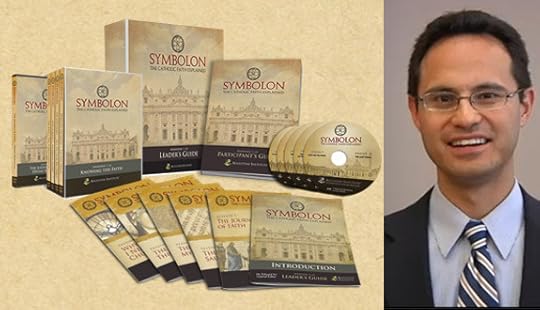
“Symbolon is designed to be a resource for adult faith formation for the new evangelization,” Dr. Edward Sri of the Denver-based Augustine Institute told CNA Aug. 20.
“The Symbolon video series proclaims the truth and beauty of the Catholic faith in a way that meets people where they are at, captivates their hearts and minds for Christ and His Church and forms them with a Catholic worldview that prepares them to engage the many cultural influences today that undermine Christian living.”
Mr. Sri is the program director for the Symbolon faith formation series, produced by the Augustine Institute and distributed by Ignatius Press and Lighthouse Catholic Media. ...
“We wanted to build a program that walks people through the entirety of the Catholic faith in a way that shapes their lives,” Mr. Sri continued. “Through the 20 episodes of ‘Symbolon: The Catholic Faith Explained’ we cover everything a Catholic needs to know about the faith.”
Dr. Sri says that "about 2,000 parishes have used Symbolon in parish life and 'thousands' of people brought the program into their homes for individual or family viewing."
Catholic World Report interviewed Dr. Sri about Symbolon earlier this year:
CWR: What was the genesis of Symbolon, and how did the program come about? Who are some of the folks involved in producing the program?
Dr. Sri: The program originally was intended for RCIA, but we quickly saw that it would have a much wider impact being used by parishes and individuals for any adult faith formation setting. Many parish and diocesan directors of catechesis who saw some of the initial episodes said, “We want to use this for adult faith formation, for men’s groups, women’s groups, marriage and family ministry!” And that’s fitting. The Church teaches that the RCIA is the model form of adult catechesis since many adult Catholics need to go through the same stages of conversion as those who are entering full communion in the Church. Indeed, as John Paul II once said, many adult Catholics are “quasi-catechumens” (Catechesi Tradendae, 44).
So the Symbolon program, from its very beginning, had a focus on evangelization, on leading souls through the Catholic faith step-by-step in a way that inspires them to surrender their lives more to Jesus Christ and to live in communion with him in the Church.
The Augustine Institute produced Symbolon with our amazing video and print production team we have right here on our campus in Denver. Some bishops expressed to our President Dr. Tim Gray the challenges facing RCIA today and encouraged him to have the Augustine Institute develop a new program. It was his vision to go in this direction and build the team and the studios that made this all possible. His vision for the Augustine Institute to form Catholics for the New Evangelization through training and through resources like Symbolon has brought together a team of very talented people to serve in this mission.
And it truly is a team effort here at the Augustine Institute. I was blessed to work alongside our faculty, our production team, and many catechists around the country on the development of the curriculum, the video series and the supplemental parish resources. In particular, Lucas Police, who is the Associate Director of Symbolon at the Augustine Institute, was invaluable. His many years of experience in parish and diocesan catechetical work helped ensure we were not just making a beautiful Catholic video, but one that would serve the Church’s evangelizing and catechetical mission well.
CWR: There have been a number of catechetical programs produced in recent years. What are some of the particular strengths and unique features of Symbolon?
Dr. Sri: Many of the individuals and parishes leaders who have been using Symbolon have said it’s unique in that it provides a comprehensive A-to-Z presentation of the Catholic faith. One person described it as a “one-stop shopping” kind of program covering everything from The Trinity, Creation, the Cross, and the Church to the Bible, the sacraments, Mary, and the Church’s moral teachings on sexuality, marriage, human life, and care for the poor. A parish director of education said she loves the program because she knows anyone going through it will be getting the breadth of the Catholic faith
People also have told us they like the fact that Symbolon has a team of teachers. It’s not just one person or a talking head. Every episode features several dynamic presenters, teaching in different settings—sometimes in Rome, sometimes in an interview format, sometimes straight to camera, sometimes giving a talk in front of a live audience. The variety of teachers, settings, and styles keeps the videos moving and engaging. Each episode leaves people hungering for more. As one person said, it creates a “to be continued” feel.
Another key feature of Symbolon is the emphasis on life application and the call to conversion. It constantly is bringing the faith to real life—how do I live this out practically in my life? It also engages current cultural questions people have today: Why do I need a Church? Isn’t Jesus just one of many great religious teachers? What is marriage? Is there really a right and wrong for everyone? Do I really have a responsibility toward the poor? And every episode culminates with a call to conversion, inviting viewers to consider how they can give their lives more to Christ through the particular aspect of the faith being discussed.
Finally, people also tell us they are immediate impressed by the beauty of the video presentation. The videos don’t just teach the faith, they show the faith through the sacred art, spectacular cinematography, the beautiful churches of Rome and the beautiful music throughout.
Read the entire review.
For more about Symbolon, visit the program's website.
Praise for Symbolon:
"Symbolon offers a complete program for adult catechesis, with written text, video and DVD, and clear instructions for leading groups of adult learners, all at the service of the beauty and truth given us in divine revelation as interpreted by the Church. The immense effort expended in creating the program will, I hope, be matched by its success in shaping minds and hearts in the Catholic faith."
- Francis Cardinal George, O.M.I., Archbishop of Chicago
"Symbolon shows prospective Catholics and long-time Catholics not just Church teachings but the Catholic way of life-not just the what but the how of the faith. It does this with a sophisticated mix of images, sound, and text. Participants become intrigued with the Church without being overwhelmed with data. They see how doctrines and practices fit together and how they are meant to be lived out in their own lives. I've never seen a faith-formation program so well thought through as Symbolon."
- Karl Keating, President of Catholic Answers and author of Catholicism and Fundamentalism
"I've admired the Augustine Institute for years as one of the finest engines of the New Evangelization in North America, and its new RCIA/adult faith formation series, Symbolon: The Catholic Faith Explained, is outstanding in every sense. Beautifully produced, rich in content and pleasing to watch, Symbolon is not just a great adult tool for teaching and learning the Catholic faith, but a joy to experience."
- Charles J. Chaput, O.F.M. Cap., Archbishop of Philadelphia
"Pope Francis, like John Paul II and Benedict XVI, has called every Catholic to be a missionary disciple, an agent of the New Evangelization. And evangelically alert Catholics must be well-formed Catholics.This splendid series will help prepare Catholics to enter mission territory every day, offering others friendship with Jesus Christ."
- George Weigel, William E. Simon Chair in Catholic Studies, Ethics and Public Policy Center
"I have long been looking for a substantial program of catechesis for the RCIA, as well as for adult religious formation. The Augustine Institute's Symbolon is the answer to my prayers. This is a beautifully produced and engaging presentation of the Catholic faith. Symbolon is not only an orthodox compendium of Catholic teaching, but also one that speaks to the questions of those searching for meaning in a secularized culture. I recommend Symbolon to any bishop or pastor who is looking for help in carrying out the New Evangelization."
- Bishop Michael Sheridan of Colorado Springs
"I like it! It meets the needs of an adult learner because it takes complex concepts and brings them into a practical form through visuals, discussion, and reflections, helping the learner apply it to their own life. It gives a wider view of what the Church teaches, rather than just what comes from Scripture."
- Ginny, St. Joseph Parish
"There are so many levels of the Church, it gets us back to the basics of our faith and explains them at a level we can understand. Symbolon helps us to bring the foundations of our faith into our everyday life."
- Ed and Karen, St. Joseph Parish,
"The videos and guides [for the leader and participants] are really good. They are good not only for RCIA candidates, but also for anyone looking for a refresher on their faith. We want to use the videos to do ongoing training with our catechists. For instance, this fall, I want to invite all our catechists to come together and delve into the episode entitled ‘Who is Jesus?' "
- Brian Desmarais, Church of St. Mary, Tulsa, OK
"Everyone - parents, couples, older [parish] members - are all loving the richness of the videos, and what they are learning. The videos are so captivating and informative! The real key though is that parishioners can access the materials online, wherever they are at, and go deeper with them. Some of our parish moms can't make it to our Wednesday night sessions, so they are going through the sessions at home with their families. Recently, our parish's deacon came up to me and told me that he is hearing a lot of good things about Symbolon from parishioners. It is very exciting to watch it grow in our parish!"
- Belinda Minzenmayer, St. Luke, Temple, TX
"I like the way it is presented, easy to understand. It takes the basics of our Catholic faith and gets right to the point. It seems to talk to everyone; anywhere they are at with their faith."
- Francis, St. Joseph Parish
"I think Symbolon is awesome and I hope all RCIA programs will think seriously about using this program. What I like most is the way knowledgeable Catholic Scripture scholars and theologians present the material through a teaching dialogue. Also, the content of the class keeps the group focused on the truths of the faith and guides them with authentic Catholic teachings. I love the beautiful visuals presented in the videos and I like the way the presenters talk about the authenticity and beauty of our Catholic faith, along with their ability to simplify the truths of the Church's teachings. I think the format of the class provides a well balanced approach between class discussion and presentation. Great job, Augustine Institute!!!!!"
- Mary, Blessed John the XXIII Parish
"I like using Symbolon because the brief videos fit with our busy schedules. The lessons are already prepared and I can focus on the faith."
- Chris H, Parish Dad
"Every Sunday night we sit and discuss the readings. My kids remember and understand what they heard at Mass. "
- Jan P, Parish Mom
New: "Not God's Type: An Atheist Academic Lays Down Her Arms"
Now available from Ignatius Press:
Not God's Type: An Atheist Academic Lays Down Her Arms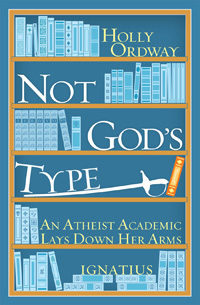 Something Other Than God - Hardcover
Something Other Than God - Hardcover
September 4, 2014
China’s Modern Martyrs: From Mao to Now (Part 4)
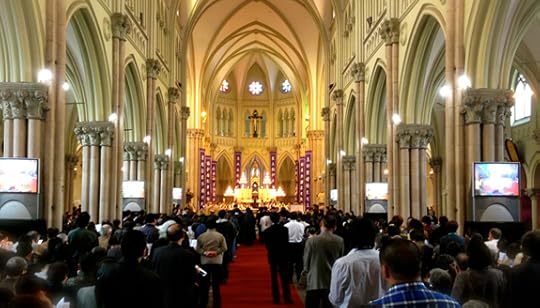
Mass at St. Ignatius cathedral in Shanghai – photo taken during the Requiem Mass of Bishop Aloysius Jin Luxian. Source: Author’s private collection.
China’s Modern Martyrs: From Mao to Now (Part 4) | Anthony E. Clark, PhD | Catholic World Report
The blood of martyrs has proven to be the seed of the Church in China, as vibrant communities thrive despite government interference and restrictions.
Part 4, Resurrection
“We should be glad and rejoice. As the Shanghai Catholic youths said: ‘We are greatly honored to have been born and lived at this important time.’” — Cardinal Kung Pin-mei, Sermon for Catholics in China (Rome, June 30, 1991)
When I published my book, China’s Saints, in 2011, I thought that only a few interested scholars would read it. I wrote it, after all, as an academic study, a work for curmudgeonly professors like myself more inclined to read objective history than pious hagiography. So I was surprised when a Jesuit priest mentioned to a large crowd of academics and ecclesiastics recently gathered in Chicago that he had been reading my book “for his daily devotions.”
Results seldom match expectations, and that is the theme of my final entry in this four-part series on China’s Catholic martyrs from Mao to now. In truth, even the most objective historian—secular or religious—must admit that decades of suppression, persecution, and suffering have resulted in a vibrant Catholic community. I shall here outline the “ongoing growth of these communities,” as Father Jeremy Clarke puts it, “even in spite of attempts to make them disappear.”
In the first three installments of this series I focused on a very dark era in the history of Chinese Catholicism: the attack against Yangjiaping Trappist Abbey and the massacre of many holy monks, Chairman Mao’s malicious media campaign against the Church, the wave of arrests that followed, and the atrocious martyrdoms of such priests as Father Beda Chang and Father Wang Shiwei. I have also recounted the Maoist destruction of Catholic churches during the Cultural Revolution (1966-1976) and more recent efforts to suppress popular Catholic devotions in China, such as the annual pilgrimage to honor Our Lady of China at Donglü. No one can deny the genuine suffering that Christians have encountered in China in recent decades, but as St. Augustine famously asserted, “God had a son on earth who was without sin, but he never had one without suffering.”
Still, China’s Christians have an optimistic view of their experiences. Elderly Catholics use the word chiku (吃苦) to describe their lives during the Maoist period (1949-1976), which literally means “having tasted bitterness.” One priest noted, “When we were bombarded with anti-Christian propaganda, we had tasted bitterness. We did not swallow it. We survived.” China’s Catholics have done more than survive; they have flourished. Over the years I have travelled in China by mule, train, plane, boat, taxi, bicycle, and long distances on foot to visit important places in the history of Christianity in China, and each year I am astonished by the unprecedented progress of the Church there.
Bishops, priests, sisters, and common faithful have told me their stories—and so have atheists, agnostics, and party members. In fact, party members have informed me that there are many persons in positions of influence who view religion as a “healthy human expression.”
September 3, 2014
"Heinrich Denzinger had a good idea"—and it's going strong 160 years later
Russell Shaw, on the OSV.com site, writes:
Heinrich Denzinger had a good idea. So good, in fact, that his idea is still going strong after 160 years. 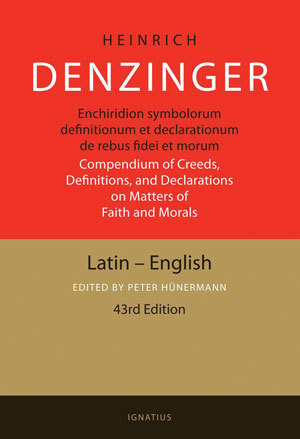
Father Denzinger, a German theologian of the 19th century, saw a need for a collection of creeds, ecumenical council decrees and teaching documents of popes to help theologians, homilists and serious readers concerned to know what the Catholic Church really teaches, as the teaching is set forth in official documents of the magisterium — the Church’s teaching authority.
German Catholic theology
The first edition of the volume users would come to call simply “Denzinger” rolled off the press in 1854 — by coincidence, the year Pope Pius IX infallibly defined the dogma of Mary’s Immaculate Conception.
It featured texts from 100 documents of the pope of that day, Pius IX. By contrast, the contents of the recently published 43rd edition extend from an Ethiopian “Letter of the Apostles” dating between A.D. 160 and 170 to an instruction on bioethics published by the Vatican’s Congregation for the Doctrine of the Faith in 2008 (“Compendium of Creeds, Definitions, and Declarations on Matters of Faith and Morals,” (Ignatius Press, $69.95)).
The English translation of this new edition is the first in that language since the 30th edition in 1957. It joins editions in Italian, French, Spanish, Portuguese and Croatian — as well as German, of course. Korean and Chinese translations also are planned.
For people accustomed to using Denzinger in their work, the English version’s publication is a notable event as well as a formidable specimen of book publishing.
Along with the texts in their original languages (usually Latin, occasionally Greek) accompanied by versions in the vernacular, its 1,437 pages include a “systematic index” grouping the documents under 12 headings (“God Reveals Himself,” “God Saves Man through Jesus Christ,” “God Calls Man to a Moral Life in Community,” etc.), several specialized indexes and a historical introduction by the volume’s current editor, Peter Hünermann.
The texts are organized chronologically, with documents grouped according to the pontificates during which they were published.
By far the largest set is the one from the long pontificate of Pope St. John Paul II, which began with his election on Oct. 16, 1978 and ended with his death on April 2, 2005. Texts in Denzinger from the Johannine era number 49.
Read the entire piece: "'Denzinger' still filling the void" (Aug. 27, 2014).
To learn more or to order: Enchiridion Symbolorum: A Compendium of Creeds, Definitions and Declarations of the Catholic Church.
The Roots of the Political Use and Abuse of the Bible

A protester dressed as the Bible joins demonstrators outside the U.S. Supreme Court in Washington June 30, 2014. (CNS photo/ Jonathan Ernst, Reuters)
The Roots of the Political Use and Abuse of the Bible | Dr. Leroy Huizenga | CWR
Scott Hahn and Benjamin Wiker's book, Politicizing the Bible, examines how the development of biblical scholarship has severed Scripture from the heart of the Church.
The Bible continues to play a large role in American public life, as politicians, candidates, and activists advert to it directly and employ its cadences in support of a variety of positions, programs, and policies. In recent decades, Barack Obama has been quite willing to employ the Bible in service of progressive purposes, while Bill Clinton went so far as to offer voters a “new covenant.” On the Republican side, George W. Bush called America “the Light of the World”, while Ronald Reagan appropriated biblical language and even declared 1983 "The Year of the Bible". This political use of the Bible in American discourse is not new, of course. The speeches, writings, and sermons of Dr. Martin Luther King Jr. were well woven with the fine natural threads of biblical inflection and images. Decades earlier in 1896, William Jennings Bryan warned that advocates of the gold standard would “crucify mankind on a cross of gold.” And of course well before that the Puritan settlers envisioned America as a new promised land and the ultimate city on a hill, the latter a dominical phrase employed later by both John F. Kennedy and Reagan.
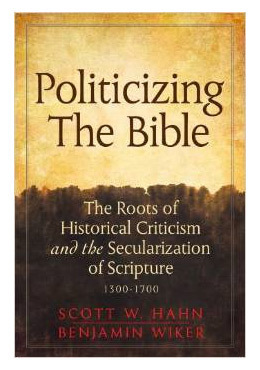
One does not find this political use of the Bible very much across the ocean in Europe, except among fringe Christian parties. Even politicians affiliated with historic parties with “Christian” in their very name—such as the Christian Democratic Union in Germany—generally don’t employ anything like “Gott segne Deutschland”in the way American politicians toss out the tagline “God bless America.” The reason, I suppose, is that the Bible holds little real cultural authority in secular, post-Christian societies, and if America is indeed heading that way, it’s not there yet. Enough American citizens regard themselves as Christians for politicians to keep using the Bible politically, often in ways that can only be deemed idolatrous in that they mistake America for God, or Jesus, or biblical Israel, and blasphemous in that they may violate the Second Commandment’s violation of taking the name of the LORD for vain purposes.
Modern Scholarship, Secular Ends
The rule, then: Where Christian faith matters to a substantial number of the electorate, there politicians, candidates, and activists will employ the Bible. But this is neither a new nor a uniquely American phenomenon. For the Bible has played a role in a number of empires, societies, tribes, and nations, and where it has, those who would wield power have tried to wield biblical interpretation to serve their purposes.
Such is the subtle line taken in Scott Hahn and Benjamin Wiker’s recent book, Politicizing the Bible: The Roots of Historical Criticism and the Secularization of Scripture 1300-1700 (Crossroad, 2013).
September 2, 2014
What Should the October Synod Discuss?
What Should the October Synod Discuss? | Fr. Cormac Burke | Homiletic & Pastoral Review
I must say that we are blinking at reality if we do not face up to the fact that since the 1950s, marriage and the family, outside and inside the Church, have been plunged into an ever-growing crisis—to the extent that their nature, and very existence, are threatened by total collapse.
Judging by the media reports on the Extraordinary Synod to be held in Rome this October, the bishops present will be mainly concerned with issues such as the admission to the Eucharist of divorced and remarried persons, the speeding up of annulment processes, and the possible revision of the Church’s teaching on contraception. Implicit in most of the reports is the view that a liberalization or “relaxation” of the Church’s present discipline in these matters could help to ameliorate the pastoral problem or concern that the Synod is called to examine. What could be said about this view?
First, it must be remembered that the Synod is on the Family, not on Marriage. Certainly the health of the family depends on the health of marriage; hence the two questions are intimately connected. Yet, if the topics so highlighted by the media are discussed, then it should be in the light of their relevance to the health of the family itself.
From this latter point of view, divorce, annulments, and contraception certainly have their impact on the quality of family life. But surely it is a negative impact, not a positive one? Hence, proposals to make them more “available” or more “acceptable” would seem to run clear counter to the presumed purpose of the Synod.
What in fact is this purpose? Why has the Synod been convoked?
Carl E. Olson's Blog
- Carl E. Olson's profile
- 20 followers




